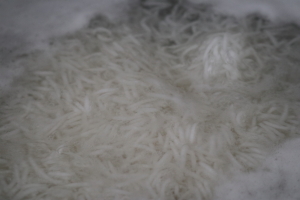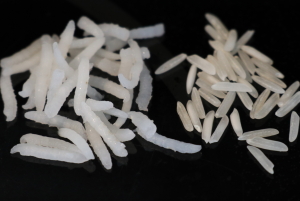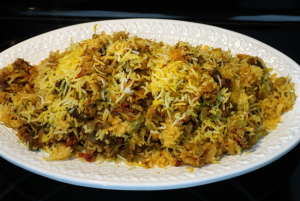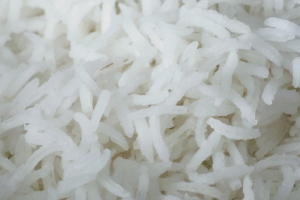There are two ways that Iranians cook the rice
1 – Boil, Drain, and Steam (Abkesh)
2 – Boil and Steam (Katéh)
Abkesh
Abkesh is the most common method and produces a fluffy rice with an excellent taste. Also the boiled rice can be mixed with different types of other ingredients to make a wide variety of traditional Iranian meals called POLO (like Cabbage Meat Rice).
Kateh
Kateh is quicker and easier. It is popular in north of Iran and makes a rice with preserved nutrition values but the cooked rice is a little bit sticky. This type of cooked rice is, traditionally, served with meat and other cooked ingredients (like Katéh-Kabab).
In both methods it is advised to wash the rice grains 3 to 4 times until water become clear. Washing the rice helps to remove most of its preservatives. You may wash the rice ahead of time and keep it soaked in salty water. The rice has more time to absorb water and salt and becomes tastier.

Ingredients to make for 2-3 people
- 1 Cup of Basmati or similar rice
- 2 litres of water
Abkesh
In a 4-litre skillet add 1 tablespoon salt and water and boil over high heat. Add rice and cook for 5 minutes or until the rice is cooked. One needs some experience to identify the optimum cooking point of a rice grain and, with the experience, you can do it by eye. A well cooked rice grain is expanded 2 to 3 times in volume but still stays solid and fluffy.

Be careful and do not overcook the rice, otherwise the rice grains would be disintegrated in water. Also note that the under cooked rice is not tasty. It should be also noted that the cooking point of a rice grain varies form one type of rice to another. This is the basic rule; The rice is ready when the rice grains expand 2-3 times in size and appeared to float on the surface of boiling water. If you press the cooked rice grain with your thumb you shouldn’t feel any solid part.

Drain the rice in a strainer and rinse with cold water. Taste the rice to make sure that it is not too salty. Rinse more to remove the excess saltiness.
At this stage there are two cooking options.
1 – Polo
Mix the strained rice with other prepared ingredients, layer by layer, in the same skillet, cover, and return to a low heat and cook for another 20 minutes. See Cabbage Meat Rice as an example of POLO (Kalampolo)

2 – Chelo
Return the strained rice to the skillet, cover, and cook for another 20 minutes over very low heat.

Kateh
In a 4-liter skillet add rice water and 1 teaspoon salt so that the height of the water on top of the rice is about 2-cm.
Cook in high heat without the skillet lead until the water is evaporated and the rice is soft. Lower the heat to minimum, cover the skillet, and cook for another 20 minutes.
To steam the rice, it is very common to cover the skillet lead with a kitchen towel that absorbs the condensed evaporated water and preventing it to drop back to the rice.
Notes
The 20-minute time for steaming the rice at low temperature is a little imprecise and may vary depending on different parameters such as skillet size, its bottom thickness, and the real heat produced by the cooking plate. Therefore, keep eye on the rice while cooking and check occasionally.
If you strain the rice in kitchen sink elevate the strainer from the bottom of the sink. The drained water from the sink bottom may flow back to the strainer and contaminates your rice.




Recent Comments